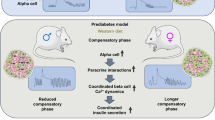Abstract
In this study, the molecular mechanisms of pancreoprotective action of the tetrapeptide H-Lys-Glu-Asp-Trp-NH2 in aging human pancreatic cells have been investigated. It has been established that the tetrapeptide under study increases the expression of matrix metallopreteinases MMP2 and MMP9, serotonin, glycoprotein CD79α, antiapoptotic protein Mcl-1, and proliferation markers PCNA and Ki67, as well as decreases the expression of proapoptotic protein p53 in aged pancreatic cell cultures. Thus, the clinical effect of the tetrapeptide observed in elderly patients with type-2 diabetes mellitus and pancreatitis may be due to its ability to activate the expression of signaling molecules, i.e., markers of functional activity of pancreatic cells.
Similar content being viewed by others
References
Dedov, I.I., Diabetes mellitus in the Russian Federation: problems and solutions, Sakharnyi Diabet, 1998, no. 1, pp. 7–21.
Minushkin, O.N., Chronic pancreatitis, Ter. Arkh., 2001, vol. 73, no. 1, pp. 62–65.
Allagnat, F., Cunha, D., Moore, F., et al., Mcl-1 downregulation by pro-inflammatory cytokines and palmitate is an early event contributing to π-cell apoptosis, Cell Death Differ., 2011, vol. 18, no. 2, pp. 328–337.
Anisimov, V.N. and Khavinson, V.Kh., Peptide bioregulation of aging: results and prospects, Biogerontology, 2010, no. 11, pp. 139–149.
Evan, G. and Lifflewood, T., A matter of life and cell death, Science, 1998, vol. 281, no. 5381, pp. 1317–1322.
Fedoreyeva, L.I., Kireev, I.I., Khavinson, V.Kh., and Vanyushin, B.F., Penetration of short fluorescencelabeled peptides into the nucleus in HeLa cells and in vitro specific interaction of the peptides with deoxyribooligonucleotides and DNA, Biochemistry, 2011, vol. 76, no. 11, pp. 1210–1219.
Jayaraman, S., Epigenetics of autoimmune diabetes, Epigenomics, 2011, vol. 3, no. 5, pp. 639–648.
Khavinson, V.Kh., Malinin, V.V., Grigoriev, E.I., and Ryzhak, G.A., US Patent 7491703, 2009.
Khavinson, V.Kh., Linkova, N.S., Polyakova, V.O., et al., Peptides tissue-specifically stimulate cell differentiation during their aging, Bull. Exp. Biol. Med., 2012, vol. 153, no. 1, pp. 148–151.
Khavinson, V.Kh., Gavrisheva, N.A., Malinin, V.V., et al., Effect of pancragen on blood glucose level, capillary permeability and adhesion in rats with experimental diabetes mellitus, Bull. Exp. Biol. Med., 2007, vol. 144, no. 4, pp. 559–562.
Kobayash, H., Doi, R., Hosotani, R., et al., Immunohisto-chemical analysis of apoptosis-related proteins in human embryonic and fetal pancreatic tissues, Int. J. Pancreatol., 2000, vol. 27, no. 2, pp. 113–122.
Korkushko, O.V., Khavinson, V.Kh., Shatilo, V.B., et al., Prospects of using pancragen for correction of metabolic disorders in elderly people, Bull. Exp. Biol. Med., 2011, vol. 151, no. 4, pp. 454–456.
Mäkinen, K., Loimas, S., Hakala, T., and Eskelinen, M., Tumor suppressor protein (p53), apoptosis inhibiting protein (Bcl-2) and proliferating cell nuclear antigen (PCNA) expressions in a rat pancreatic tumor model, Anticancer Res., A, 2007, vol. 27, no. 1, pp. 23–26.
Miralles, F., Battelino, T., Czernichow, P., and Scharfmann, R., TGF-beta plays a key role in morphogenesis of the pancreatic islets of Langerhans by controlling the activity of the matrix metallo-proteinase MMP-2, J. Cell Biol., 1998, vol. 143, no. 3, pp. 827–836.
Paulmann, N., Grohmann, M., Voigt, J.-P., et al., Intracellular serotonin modulates insulin secretion from pancreatic (β-cells by protein serotonylation), PLoS Biol., 2009, vol. 7, no. 10, p. e1000229.
Perez, S.E., Cano, D.A., Dao-Pick, T., et al., Matrix metallo-proteinases 2 and 9 are dispensable for pancreatic islet formation and function in vivo, Diabetes., 2005, vol. 54, no. 3, pp. 694–701.
Wild, S., Roglic, G., Green, A., et al., Global prevalence of diabetes: estimates for the year 2000 and projections for 2030, Diabetes Care, 2004, vol. 27, no. 5, pp. 1047–1053.
Author information
Authors and Affiliations
Corresponding author
Additional information
Original Russian Text © V.Kh. Khavinson, N.N. Sevostyanova, A.O. Durnova, N.S. Linkova, S.I. Tarnovskaya, A.V. Dudkov, T.V. Kvetnaya, 2012, published in Uspekhi Gerontologii, 2012, Vol. 25, No. 4, pp. 680–684.
Rights and permissions
About this article
Cite this article
Khavinson, V.K., Sevostyanova, N.N., Durnova, A.O. et al. Tetrapeptide stimulates functional activity of pancreatic cells in aging. Adv Gerontol 3, 220–224 (2013). https://doi.org/10.1134/S2079057013030053
Published:
Issue Date:
DOI: https://doi.org/10.1134/S2079057013030053




